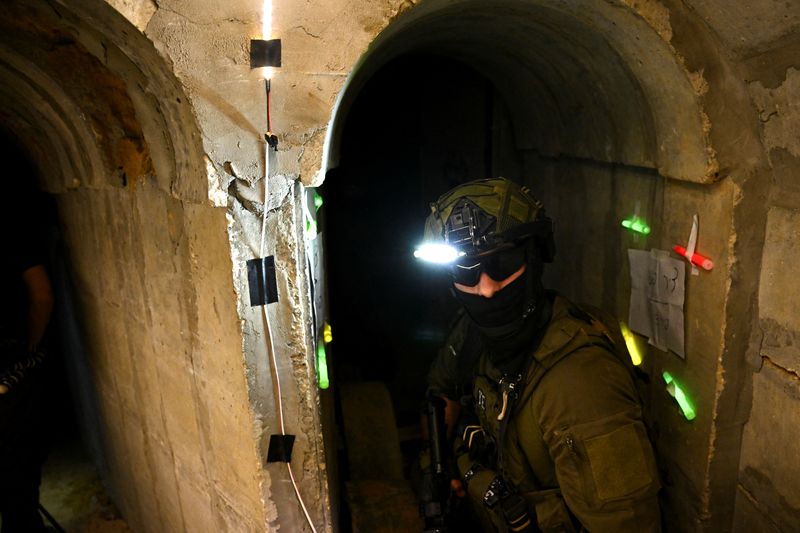
©Reuters. An Israeli soldier stands in what the military described as a Hamas command tunnel that runs partly under the UNRWA headquarters, amid the ongoing conflict between Israel and the Palestinian Islamic group Hamas, in the Gaza Strip , February 8, 2024. REUTERS/Dyl
2/2
By Dylan Martinez
GAZA (Reuters) – Israeli forces have discovered a network of tunnels hundreds of meters long running partly under UNRWA’s Gaza headquarters, the military said, calling it new evidence of Hamas’ exploitation of the main agency relief for the Palestinians.
Army engineers took journalists for foreign news outlets through the steps at a time of crisis for UNRWA, which launched an internal investigation and saw a number of donor countries freeze funding following the month’s allegations report by Israel that some of its personnel were also acting as Hamas agents.
The Palestinians have accused Israel of falsifying information to smear UNRWA, which employs 13,000 people in the Gaza Strip and has for years been a lifeline for the aid-dependent population. The agency runs schools, primary health clinics and other social services and distributes aid, describing its activities as purely humanitarian.
UNRWA’s headquarters are in Gaza City, among the northern areas that Israeli troops and tanks overran at the start of the four-month war against the ruling Islamic faction Hamas, forcing hundreds of thousands of civilians to flee towards south.
The tightly escorted journalists on the trip entered a shaft near a school on the outskirts of the United Nations complex, descending into the concrete-lined tunnel. Twenty minutes of walking through the stiflingly hot, narrow and sometimes tortuous passage brought them under UNRWA headquarters, said an Army lieutenant colonel leading the tour.
The tunnel, which the military said was 700 meters long and 18 meters deep, sometimes bifurcated, revealing side rooms. There was an office, with steel safes that had been opened and emptied. There was a tiled bathroom. One large room was filled with computer servers, another with industrial batteries.
“Everything is conducted from here. All the energy for the tunnels you passed through is fed from here,” said the lieutenant colonel, who gave only his first name, Ido.
“This is one of the central intelligence commands. This place is one of the Hamas intelligence units, where they commanded most of the fighting.”
But Ido said Hamas appeared to have evacuated in the face of the Israeli advance, preemptively cutting communications cables that, in an above-ground portion of the tour, he showed running through the basement floor of UNRWA headquarters.
It appeared that heavy Israeli barrages and prolonged winter rains may also have played a role in the departure: several sections of the tunnel were clogged with displaced sand and knee-deep water.
In a statement, UNRWA said it left its headquarters on October 12, five days after the war began, and was therefore unable to “confirm or otherwise comment” on the Israeli discovery.
“UNRWA… does not have the military and security expertise or capacity to undertake military inspections of what is or may be under its premises,” the statement read.
“In the past, whenever (a) a suspicious cavity was found near or under UNRWA premises, letters of protest were promptly sent to the parties to the conflict, including both the de facto authorities in Gaza (Hamas) and the Israeli authorities .”
UNRWA supporters say it is the only agency with the means to help the Palestinians’ worsening humanitarian hardship. Israel says the agency is “pierced by Hamas” and needs to be replaced. Hamas has denied operating in civilian facilities.
“We know that they (Hamas) have people working in UNRWA. We want all international organizations to work in Gaza. This is not a problem. Our problem is Hamas,” Ido told reporters.
The lack of cell phone reception in the tunnel made geolocation impossible as under the UNRWA headquarters. Journalists were instead asked to place personal items in a bucket lowered by a rope into a vertical hole on the headquarters grounds. They were reunited with the items still tied up during the tunnel tour.
As a condition of taking the journalists on the trip, the Israeli army did not allow military intelligence photographs such as maps or certain equipment in the convoy of armored vehicles in which they were traveling. It also required approval before broadcasting photographs and videos taken on site. voyage.